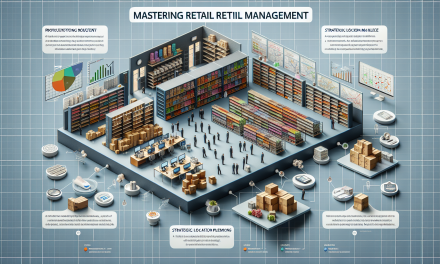Table of Contents
- Introduction
- The Importance of Efficient Logistics and Inventory Control
- Modern Methods of Logistics Processing
- Innovative Inventory Control Techniques
- Challenges in Logistics and Inventory Control
- FAQs
- Conclusion
Introduction
In today’s fast-paced business environment, effective logistics processing and inventory control are crucial to maintaining a competitive edge. Companies increasingly look for the latest methods to streamline operations, minimize costs, and improve customer satisfaction. This blog post will dive deep into emerging techniques in logistics processing and inventory management, equipping businesses to thrive.
As a primer, consider the Inventory Control & Logistics Management: Advanced Techniques Course for further insights.
The Importance of Efficient Logistics and Inventory Control
Logistics and inventory control form the backbone of any supply chain. Effective management of these elements ensures timely delivery of goods, reducing operational costs and enhancing customer experience. Essentially, smooth logistics operations contribute to improved profitability, while robust inventory control ensures that businesses can respond promptly to market demands.
Modern Methods of Logistics Processing
Automation in Logistics
As technological advancements continue to reshape the logistics landscape, automation has emerged as a pivotal method in processing logistics. By automating routine tasks such as order processing, data entry, and inventory tracking, businesses can significantly reduce human error and increase efficiency. Moreover, automated systems provide real-time data, enabling companies to make more informed decisions quickly.
Cloud-Based Logistics Management
Cloud technology has revolutionized how companies manage their logistics. With cloud-based solutions, businesses gain real-time access to inventory levels, shipment tracking, and supplier data, all from a centralized platform. This approach not only enhances visibility but also facilitates better collaboration among various stakeholders. Additionally, it reduces costs associated with IT infrastructure and maintenance.
Big Data Analytics
Big data analytics empowers businesses to make data-driven decisions in logistics. By analyzing vast amounts of data, companies can forecast demand more accurately, optimize routes, and improve overall operational efficiency. For instance, organizations can leverage consumer behavior data, seasonal trends, and historical sales information to adjust inventory levels proactively.
As businesses strive to embrace this technology, it’s also essential to learn how to harness its full potential. Resources like Unlocking the Power of Big Data Analytics for Supply Chain Optimization explain how data can transform logistics operations.
Innovative Inventory Control Techniques
Just-In-Time Inventory System
The Just-In-Time (JIT) inventory system focuses on aligning orders with production schedules to minimize inventory levels. This method encourages businesses to receive goods only as they are needed in the production process, which reduces waste and frees up resources that would otherwise be tied up in inventory. Implementing JIT effectively requires robust communication with suppliers and precise demand forecasting.
ABC Analysis
ABC analysis categorizes inventory into three classes: A, B, and C, based on their significance. Class A comprises high-value items that require tight control, while Class C includes low-value items that need less oversight. By prioritizing inventory management efforts, companies can allocate resources efficiently and maintain optimal stock levels.
To master more advanced techniques, you can explore Mastering Advanced Purchasing Management.
Cycle Counting
Cycle counting is an inventory auditing procedure that counts a subset of inventory in rotation throughout the year. Instead of performing one large inventory count, businesses conduct smaller counts more frequently, ensuring accuracy without disrupting operations. This technique allows for quicker identification of discrepancies, enabling timely corrective actions.
Challenges in Logistics and Inventory Control
Despite advancements in technology and techniques, organizations still face numerous challenges in logistics processing and inventory control. For instance, supply chain disruptions can lead to inventory shortages, while unforeseen demand fluctuations may lead to overstocking.
Moreover, integrating new technologies into existing systems poses another hurdle for many companies. Organizations must invest time and resources to train employees and adapt processes to leverage new tools effectively. Additionally, data security concerns surrounding cloud-based systems warrant careful consideration.
FAQs
What are the primary benefits of automating logistics processes?
Automating logistics processes leads to increased efficiency, reduced errors, and real-time data access that facilitates informed decision-making.
How can big data improve inventory management?
Big data enables better demand forecasting, optimal inventory levels, and overall enhanced operational efficiency through data analysis.
What is the challenge of implementing a Just-In-Time inventory system?
The main challenge lies in maintaining effective communication with suppliers and accurately forecasting demand to avoid stockouts.
How can ABC Analysis benefit inventory management?
ABC analysis helps prioritize inventory management efforts by focusing on high-value items, enabling more efficient resource allocation.
Conclusion
In conclusion, adopting the latest methods of logistics processing and inventory control is essential for organizations aiming to enhance efficiency and respond effectively to market demands. By embracing technologies like automation and big data analytics, along with innovative inventory management techniques, businesses can position themselves for success in an increasingly competitive landscape. Ultimately, ensuring that your organization stays ahead of trends will not only improve operations but also enhance customer satisfaction and drive profitability.
To dive deeper into advanced techniques for inventory control and logistics management, consider exploring more resources, such as Unlocking Success in International Trade and Shipping: Skills for Tomorrow and Master Procurement Strategies: A Deep Dive into Buyer Roles and Skills.





